#sponge fossil
Explore tagged Tumblr posts
Text




Like the pic before last evening yesterday, found this flat top piece of an brown echinodem fossil top, with flat cut grey open underside. Without many other stones here.
Then on the route back the half piece end of an new aulaxinia sulficera sponge with this wave pattern, was on the back walk from the stone road.
#fossils#fossil collecting#collecting rocks#geology#rocks#flint fossil#echinoid#fossils in germany#fossils 2024#sponge fossil
81 notes
·
View notes
Text


The new finds from the today trip to the mentioned stone road & one location with piles.
They are sponges aulaxinia sulficera - the in lengt two again and the round stone with the mold on it. I have already an specimen like this in dark flint.
Then the in half round open chert/ flint cut sponge with the inner pattern.
The first like this with an clear pattern of some struckture shown!!
And an absolutly tiny echinoid core, if you zoom in you can see the little reminicent pattern.
At first without cleaning, i was thinking it was an fungus on it, but afterwards the pattern is in the flint, likely calcite.




#fossils#geology#fossil hunt#fossil collecting#aulaxinia sulficera#sponge fossil#fossils in germany#fossils 2024#echinoid#fossil friday#fossil
16 notes
·
View notes
Photo

Rare Fossil Sponge Porosphaera globularis – Upper Chalk Cretaceous, Kent UK – Genuine with COA
Discover a rare and fascinating piece of Earth’s ancient marine history with this authentic fossil sponge – Porosphaera globularis, dating from the Upper Chalk of the Late Cretaceous period. This unique specimen was sourced from Kent, UK, a region renowned for its rich fossil-bearing chalk formations.
Porosphaera globularis is a globular-shaped sponge species commonly found in chalk deposits and known for its distinctive porous structure. These sponges lived approximately 70–90 million years ago when much of Europe was submerged under a warm, shallow sea. Their preservation in chalk provides an incredible window into ancient marine ecosystems.
Item Details:
Species: Porosphaera globularis
Age: Upper Chalk, Late Cretaceous (~70–90 million years old)
Location Found: Kent, United Kingdom
Condition: 100% genuine fossil specimen with clear structural features
Scale: Scale cube in photo is 1cm – please refer to images for full sizing details
Photography: The specimen shown is the exact item you will receive
Packaging: Securely packaged to ensure safe delivery
This fossil is ideal for collectors, educators, or anyone with a passion for natural history. It comes with a Certificate of Authenticity, affirming its genuine origin and geological significance.
All of our fossils are carefully selected for quality and scientific interest. Don’t miss the opportunity to own a real piece of prehistoric life!
#fossil sponge#Porosphaera globularis#Cretaceous fossil#Upper Chalk fossil#Kent fossil#UK fossil sponge#ancient sponge fossil#genuine fossil#fossil with certificate#educational fossil#natural history#fossil collection#sponge fossil#chalk fossils#rare fossil specimen
0 notes
Note
> Cymbastela cantharella
Okay but what is that thing? I thought it was a mushroom, but everything I found showed it as an animal? Is it like a coral or a sea sponge or what?
Cymbastela cantharella is a species of sea sponge, which are considered animals! just like us, they have tissues, eat other organisms, and sexually reproduce using sperm cells!
sponges are also believed to have been the first animal, with fossils indicating sponges may have existed over 760,000,000 years ago!
say hi to grandpa!

384 notes
·
View notes
Text
For sponge fossils reference of identification.


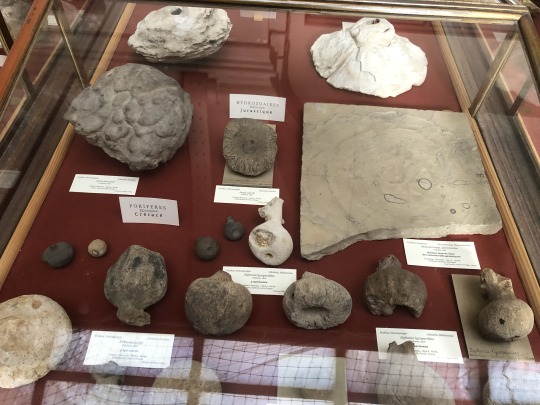
Sponges (and hydrozoa) of the Jurassic and Cretaceous.
3 notes
·
View notes
Text
Perspectives #7

"Garden of Cambrian Sights”
Innovatiocaris/Microdictyion/Haikouichthys/Eldonia/Fortiforceps
Cambrian, 518 million years ago, Maotianshan Shales (China) The Chengjiang Biota was composed of a hugely diverse array of invertebrates. Just in this picture alone, you have Innovatiocaris, Microdictyon, Fortiforceps, Eldonia, Haikouichthys, primitive annellids, priapulida, sponges, and echinoderms. It might not have always looked as helish as this, though... Based on the third panel of "The Garden of Earthly Delights" by Hieronymous Bosch.
This is a part of my Perspectives series! You can find previous entries in #perspectives on my blog.
#yee art#paleoart#paleoblr#palaeoblr#cambrian#fossil#nature art#ocean#innovatiocaris#lobopod#anomalocaris#cambrian explosion#worms#eldonia#haikouichthys#fortiforceps#sponge#shrimp#perspectives
93 notes
·
View notes
Text




Geology tingz
#geology#rocks#lab#earth though time#foraminiferans#coral#fossils#scleratinia#phacops#paleozoic#sponges#mine
22 notes
·
View notes
Text
Fossil Friday: Choia
For the last Fossil Friday this month I thought I would talk about my favorite Cambrian fossil: Choia.
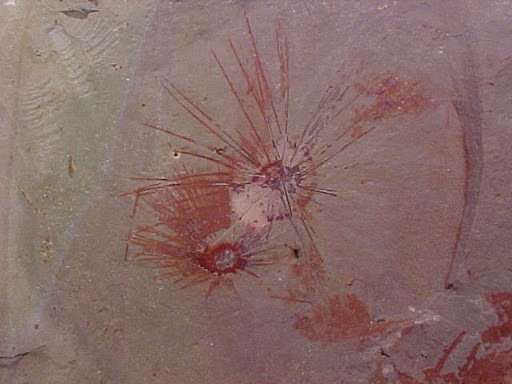
As a vertebrate paleontologist, it might seem weird that my favorite animal isn't something like Pikaia or Haikouichthys.
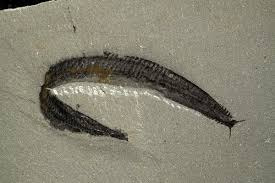
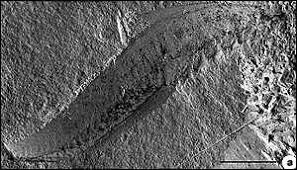
Let me explain. I was born and raised in the American southwest. Cholla (pronounced choy-uh) is a type of cactus found in southern Colorado and Utah, Arizona and New Mexico.
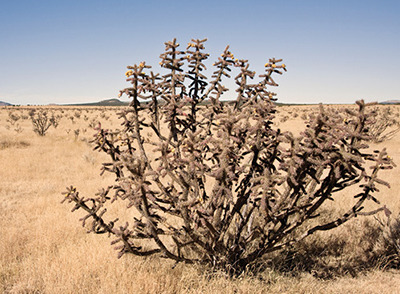
My favorite variety of cholla? Jumping Cholla. That's right. I said Jumping Cactus. This cactus uses friction to throw bits of itself at those who potentially want to steal its water and it hurts like a bitch.

There are little barbs on the ends that get lodged in the skin and you need pliers to pull them out (happened to my grandma on a date with my grandpa. Fun times for them.).
Back to the fossil Choia. It is not a cactus, nor is it even a plant. It is a type of sponge.
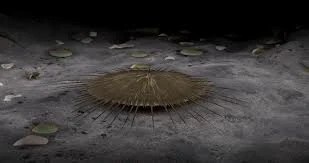
This sponge does look remarkable like a piece of cholla cactus though which is how it got its name. Now, it probably did throw its spines like the cactus but they would have made it very difficult to eat.
it is a type of demosponge, the same kind we use for bath sponges. (I don't recommend using a Choia though. There are eight species known from Canada, Utah, China and Morocco.
It was not a very big sponge at only about 2 cm in diameter though its spicules added an extra 3 cm onto that. It lived on the seafloor where spicules may have helped hold it up above the sediment-water interface.

It was a suspension feeder so particles of organic matter were extracted from the water as they passed through canals in the sponges wall.
Hope you've come to find both Choia and cholla as cool as I do. Fossilize you later!

#paleontology#fossils#paleontologist#choia#sponges#fossil friday#cambrian period#cambrian explosion#my favorite Cambrian animal
22 notes
·
View notes
Text
Archaeocyatha fossils in Wilkawillina Gorge
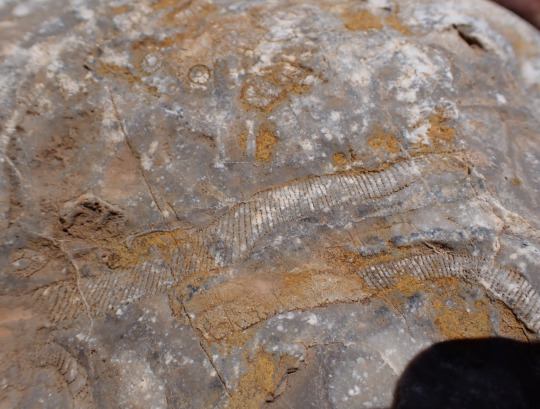

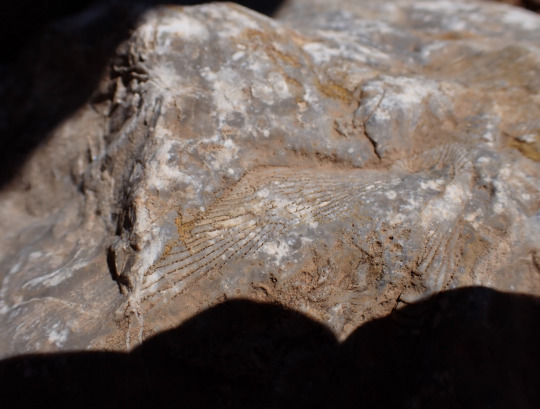
10 notes
·
View notes
Text


Some fossils from our local quarry 🤩 it's one of the oldest and best preserved fossilized coral reefs in the world, I find something cool every time I go ❤️
2 notes
·
View notes
Text






The haul of small fossils like an typical beachcore trip finds, but I was not near any beach or sea. I’m recently vary happy now.
All of this little fossils like the skeleton coral parts, mussels, belemnite nautiloide and crinoid traces found in my direct neighborhood & at my workplace area near the parking lot with the gravel rose beds.
I’m absolutely not near any sea. All new mussel & coral parts eagerly to find with luck within my work time outside from the last days.
After weeks of hopefully thinking, to find some coral traces myself on this area are now reality.
#fossils#fossil collecting#fossils in germany#limestone#flint fossil#brachiopode#belemnite#crinoid#sponge fossil#coral fossils#mussel fossil#fossiled snails#fossils 2024#fossil hunting#beachcore#brachiopods
5 notes
·
View notes
Text
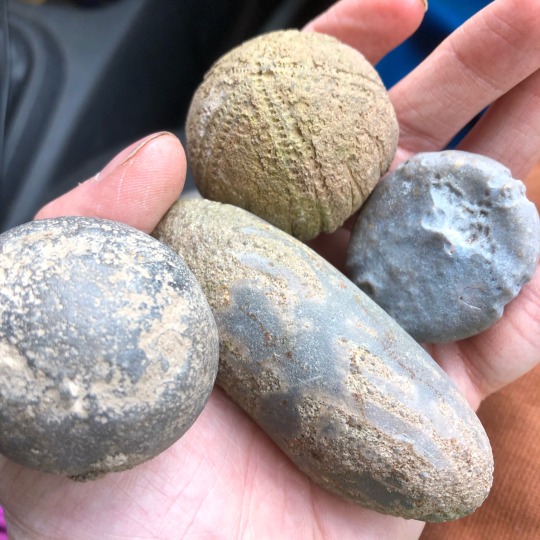

Die Fossiliensuche geht weiter !
Found some fossilised echinoderm with an handful of round amount of Aulaxinia sulcifera sponge in flint. Flint & chert are the dominant sedimented rocks here with fossil finds.
Again he and his long dead dry urchins !!
One round is fully complete with no cracks.
#fossils#fossil hunt#fossil collecting#fossils 2024#echinoderm#echinodea#sea urchin#Aulaxinia sulcifera#sponge fossil
12 notes
·
View notes
Photo

Rare Fossil Sponge Porosphaera globularis – Upper Chalk Cretaceous, Kent UK – Genuine with COA
Discover a rare and fascinating piece of Earth’s ancient marine history with this authentic fossil sponge – Porosphaera globularis, dating from the Upper Chalk of the Late Cretaceous period. This unique specimen was sourced from Kent, UK, a region renowned for its rich fossil-bearing chalk formations.
Porosphaera globularis is a globular-shaped sponge species commonly found in chalk deposits and known for its distinctive porous structure. These sponges lived approximately 70–90 million years ago when much of Europe was submerged under a warm, shallow sea. Their preservation in chalk provides an incredible window into ancient marine ecosystems.
Item Details:
Species: Porosphaera globularis
Age: Upper Chalk, Late Cretaceous (~70–90 million years old)
Location Found: Kent, United Kingdom
Condition: 100% genuine fossil specimen with clear structural features
Scale: Scale cube in photo is 1cm – please refer to images for full sizing details
Photography: The specimen shown is the exact item you will receive
Packaging: Securely packaged to ensure safe delivery
This fossil is ideal for collectors, educators, or anyone with a passion for natural history. It comes with a Certificate of Authenticity, affirming its genuine origin and geological significance.
All of our fossils are carefully selected for quality and scientific interest. Don’t miss the opportunity to own a real piece of prehistoric life!
#fossil sponge#Porosphaera globularis#Cretaceous fossil#Upper Chalk fossil#Kent fossil#UK fossil sponge#ancient sponge fossil#genuine fossil#fossil with certificate#educational fossil#natural history#fossil collection#sponge fossil#chalk fossils#rare fossil specimen
0 notes
Text
Named Cyathophycus balori, the newly-identified species lived during the Carboniferous period, some 315 million years ago. It resembled the Venus Flower Basket Sponge, which is currently found in the Pacific Ocean.
When most sponges die, they usually fall apart quickly, and often only scattered remains of the spicules are preserved as fossils,
4 notes
·
View notes
Text
For special specimen finds reference of identification.



Sponges. Big fan of their texture.
2 notes
·
View notes
Text
The fact that sea sponges are animals makes me so happy. Sponge is animal :)
#thinking of him (stromatoporoid sponges.)#apparently you can find rhem in ohio!!! (the fossils ofc)
0 notes